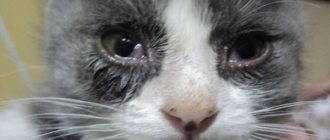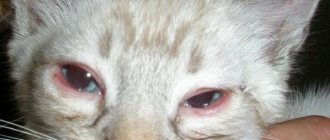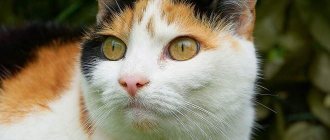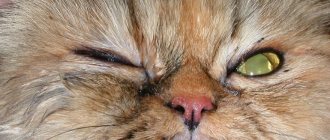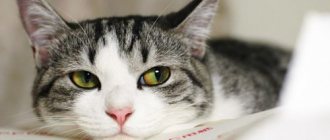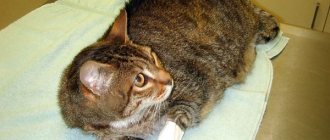What can lacrimation in cats signal? With a high probability, this indicates that some deviation from the norm has occurred in the animal’s body. Therefore, if you are faced with the fact that your pet has one eye squinted or watery, it is advisable to go to the hospital for an examination and consultation with a veterinarian. Of course, you shouldn’t panic right away, since lacrimation is not always a threat. Next, we will try to understand the reasons that can cause tears in cats, and also focus on the main options for diagnosis and treatment at home.
Common causes of watery eyes in cats
Pets, like people, have risks of developing diseases of the eyes and mucous membranes of the nose. Some of them are harmless and can be treated at home, while others require the help of a veterinarian.
The most common causes of swelling and watery eyes include viruses, infections and mechanical damage.
- One of the reasons is colds
. Cats can also become hypothermic and get a runny nose. When cats have a cold, their body temperature rises and discharge appears from the eyes, the animal is lethargic, drowsy, and does not eat well. - An infection of the mucous membrane of the eye - conjunctivitis
- is caused by pathogenic microorganisms or viruses. With conjunctivitis in cats, one or both eyes become watery, photophobia is severe, and the pet hides from bright light under the sofa or bed. - Parasites
also cause watery eyes. Not only the intestines suffer - cats have worms that live in the organs of vision. They cause inflammation, suppuration and severe lacrimation. Treatment with anthelmintic drugs is effective. - A common cause of severe watery eyes and swelling of the eyelids in cats is an allergic reaction
. Allergies occur to new food, household chemicals, dust, tobacco smoke, poplar fluff and pollen. Frequent sneezing, red eyes, itching and watery eyes are the most obvious signs of an allergy. Treatment begins by eliminating contact with a possible allergen, prescribing antihistamines and hormonal agents, if necessary. - It happens that chemicals get on the face and in the eyes of a curious cat
. In such cases, it is necessary to rinse the affected areas with running water as quickly as possible. - A foreign body entering
a cat's eye causes redness, swelling and severe tearing. To remove debris or hair, rinse your eyes with water and wipe with an antibacterial solution. In difficult cases, surgical intervention is required.
Tearing also increases when the eye is injured, for example, when the cornea is damaged by a branch or during a fight with other animals. Entropion of the eyelid is considered one of the common eye problems in hairless cats. Treatment for this is only surgical; in addition, doctors prescribe antibiotics. The prognosis is favorable, and after surgery, vision is normalized.
Trichiasis, on the other hand, is a rare pathology that occurs in cats with abnormal eyelash growth. They grow inside the eyelid, the tear ducts become inflamed from irritation and the risk of infection increases. Treatment of trichiasis is only surgical; there are no other options.
Treatment of teary eyes
If your eyes are watery, drug therapy is used for treatment. When an inflammatory process is diagnosed, a number of drugs are prescribed:
- antibiotics;
- antihistamines;
- non-steroidal anti-inflammatory drugs.
To eliminate tearing, use drops that relieve itching and swelling. For inflammatory processes, physiotherapy may be prescribed, such as phototherapy, electrophoresis, and magnetic therapy.
For dry eye syndrome, if a person has to work for a long time in the wind, in smoky or dusty rooms, or at a computer, moisturizing drops that imitate natural tear fluid are prescribed. The composition of the preparations is as close as possible to natural tears and does not cause discomfort when instilled.
Surgery is a last resort measure that is used when the tear ducts are blocked or the upper or lower eyelid is everted. If the lacrimal canal is blocked, which often happens in infants, they resort to balloon dacryocystoplasty in children or dacryocystorhinostomy.
During the first type of surgery, a guidewire with an expansion balloon is inserted into the hole in the corner of the eye and filled with fluid. Under pressure it expands the duct.
For adults, dacryocystorhinostomy is used. A new duct is created between the lacrimal sac and the nasal cavity, going around the blocked one. Laser and endoscopic dacryocystorhinostomy remain more modern and effective methods of surgical treatment of tearing.
If lacrimation occurs, it is important to promptly consult an ophthalmologist. Do not forget that the symptom may be a manifestation of an inflammatory process leading to deterioration of vision. Some pathologies with tearing lead to atrophy of the optic nerve, and sometimes blindness. Elimination of complications may require more funds.
Prevention
The eyes are an organ that allows animals and people to navigate well in space. A person knows how important it is to take care of his organ of vision, but he is not able to convey this knowledge to an animal. Cats, on an instinctive level, also try to avoid damaging their eyes, but they are predators, and the excitement of the hunt sometimes leaves no room for caution. We cannot fight this, but we can try to prevent many eye diseases in cats. For example, washing the eyes can be considered not only a therapeutic, but also a preventive procedure that helps cleanse the mucous membranes of dust and allergens and prevents the proliferation of bacterial or viral infections. This procedure is especially important for breeds with flattened faces that have problems with the outflow of tear fluid. For example, handsome Persians, who, due to the characteristics of the breed, really like to “cry,” need to wipe their eyes regularly as a morning wash. In the mornings, they experience the most active lacrimation. If your cat’s eyes are slightly sour or brown hard crusts are stuck to the fur in the corners of the eyes, it is imperative to wipe the corners of the eyes and the areas under them with a cotton swab dipped in antiseptic as a preventive measure. There is no need to try to remove unsightly brown streaks under the eyes using improvised means. For these purposes, veterinary pharmacies provide a special lotion (for example, a product called “Beaphar Sensitiv”). You need to understand that not all drugs used to treat people are suitable for animals. Before using medication to treat your pet, you should consult your veterinarian. Specialized pharmacies and veterinary clinics have many medications designed specifically for our little brothers. These are the drugs you should give preference to, since you have taken on the responsibility of caring for and loving the animal. We don’t buy veterinary drugs for ourselves. To help prevent many dangerous diseases in animals, including some eye diseases, not only hygiene procedures help, but also vaccination, which must be carried out at the appointed time, especially if the cat walks on the street or comes into contact with stray animals. But even domestic animals to the core are not 100% protected from various infections and viruses that we, the owners, can easily carry from the street on clothes or shoes. This suggests that vaccinations should be given to all animals, regardless of their habitat. Maintaining cleanliness in the house and hygiene of the organ of vision will help to avoid allergies and dust getting into the eyes of animals and people. Humidifying the air in the room will also provide a good service, which will be beneficial for both the respiratory system and the eyes. [15], [16], [17]
Diagnosis of a cat with lacrimation
To correctly diagnose a possible disease, you should observe the cat. Sometimes eye problems are accompanied by behavioral changes. Decreased activity and refusal to eat may confirm the presence of the disease. During a visual inspection it is necessary to determine:
- both eyes or only one are affected;
- how often does tearing occur?
- how much tears are produced;
- what is the purity and color of the eyeball;
- whether there are traces of blood or pus in the liquid;
- whether the mucous membranes and eyelids swell;
- Is there a prolapse of the third eyelid?
To find out the reason why your animal's lacrimation occurs, you should carefully examine the organ of vision. Before doing this, first wash your hands or wipe them with a disinfectant solution. The cat's eyes are washed to remove secretions and examined by gently pulling back the lower eyelid. Based on the diagnostic results, a clinical picture is drawn up. Signs of eye problems are determined by the condition of the visual organ and the nature of the discharge.
global $ads_google; //data-ad-slot=”2475549904″ $ads_google = empty($ads_google) ? false : true; ?> if ($ads_google == false) {?> $ads_google = true; ?> } ?>
If a cat sneezes and tears flow
The cause of excessive tearing may be due to a bacterial, fungal or viral infection. At the same time, the cat sometimes coughs, sneezes and watery eyes. With such a problem, diseases of the respiratory system cannot be ruled out. The animal is tested for mycoplasmosis and chlamydia. With a weakened immune system, the disease can last more than a week. Another reason why a cat has watery eyes, coughing and sneezing is an allergy.
If the tears have a brown discharge
The brown color of tear fluid is due to the presence of dark-colored pigments in it. There are several reasons for this lacrimation. Some cats have brown tears because they have a short, narrow tear duct. A growing tumor can lead to a narrowing of the canal. But the anatomical structure of the organ is not always the culprit. In some cases, dark liquid accumulates due to infection of the body with worms or non-infectious inflammation of the lacrimal sac. Another reason is trauma, due to which blood enters the tear secretion.
Tears and purulent discharge
If the eyes water and pus is released, then bacterial conjunctivitis, blepharitis or keratitis is diagnosed. Sometimes the disease is aggravated by a viral infection, chlamydia. If the cat suffers from allergies, the inflammatory process is aggravated. The discharge may have a yellow, greenish, or light brown tint.
Red eyes and watery eyes
The cause of reddening of the whites with excessive tearing may be an organ injury or a foreign body getting under the eyelid. If both facts are not established during the examination, the option of allergies or increased intraocular pressure is considered. With these problems, the blood vessels often dilate and the eyes water. The cat blinks frequently, squints and avoids light.
global $ads_google; //data-ad-slot=”2475549904″ $ads_google = empty($ads_google) ? false : true; ?> if ($ads_google == false) {?> $ads_google = true; ?> } ?>
The cat has one eye that is watery and swollen
If the problem affects only one eye, the most likely cause is mechanical damage to the organ. This could be an injury due to a blow or a sharp object getting under the eyelid. Also, the cat's eye waters and swells with unilateral conjunctivitis or glaucoma. The last problem is accompanied by a painful effect and disorientation of the pet in space. When diagnosing unilateral lacrimation and edema, it is necessary to exclude a tumor.
Tearing and cloudy eyes
If your cat's eyes are watery and cloudy, the cornea and lens need to be examined. If the color of the clouding is whitish or light blue, and the spot itself is matte, then the pathology is most likely associated with the cornea. If in the light, along with a decrease in the size of the pupil, the cloudy spot decreases, then the problem is related to the lens. Potential causes of turbidity and lacrimation are also infections, organic inclusions, scars, and vascular proliferation.
Possibility of treatment at home
Treatment at home has many contraindications, but there are times when a visit to the veterinarian has to be postponed. In such cases, be sure to follow the general instructions in order to ensure your pet’s comfort.
Using Sofradex to treat the eyes of a cat
For example, Furacilin has excellent ability to relieve inflammation. If the nature of the disease is bacterial in nature, then Sofradex and Levomycytin are considered the best remedies. All these medications are quite common and can be found in every pharmacy.
If there is severe swelling of the eye, which causes suffering to your pet, it is necessary to administer a solution of novocaine and hydrocortisone to your pet. It is quite logical here that you will have to contact at least a practicing specialist.
Levomitin for eye drops in cats
If a foreign object gets into the eye, you must be extremely careful when removing it. All manipulations and instruments must be sterile.
Potassium permanganate deserves special consideration. Many adherents of home self-medication suggest using a manganese solution when excreting. Although potassium permanganate is an excellent antiseptic, under no circumstances should it be used for such serious treatment. With its help, you can not only not cure your beloved pet, but also cause irreparable damage to it in the form of a chemical burn. After all, even a microscopic undissolved crystal can literally burn the thinnest cornea of the eye.
Sometimes it’s better not to take risks and immediately contact a veterinarian
In any case, if the slightest uncertainty appears, there is no need to take risks; it is better to immediately contact a veterinarian.
The reasons why a cat's eyes water may also be a consequence of allergic reactions. An excellent solution to this problem are hormonal medications prescribed during examination by a veterinarian. For a particularly complete effect, it is necessary to conduct an examination to identify the irritant. It can be absolutely any seasoning, washing powder, or even an ordinary indoor flower.
Why do Scottish Fold cats have watery eyes?
global $ads_google; //data-ad-slot=”2475549904″ $ads_google = empty($ads_google) ? false : true; ?> if ($ads_google == false) {?> $ads_google = true; ?> } ?>
Breeders and cat lovers know that Scottish kittens and adult pets often have watery eyes. In childhood, this symptom is more pronounced than in adulthood. The anatomical structure of the head and eyes of these cats has special differences. The canal coming from the lacrimal gland is shortened, so tears do not linger in the ducts and quickly come out. The predisposition is explained by the flattened shape of the skull, which determines the non-standard structure of the ocular analyzer.
Scots' eyeballs are large, so they require regular washing with tear fluid. Otherwise, the cat is at risk of drying out the cornea. At the same time, cats that show suspicious signs must be examined, since eye diseases are no less common in them than in other breeds.
Allergic reaction
With reduced immunity, a cat may experience increased sensitivity to certain substances. This could be new food, natural products, tray filler, medications, volatile compounds. The body's response to the irritant is expressed in the form of allergic conjunctivitis. The cat's eyes become watery, the edge of the eyelids or eyeball turns red, and swelling appears. Sometimes there are accompanying behavioral symptoms: lethargy, apathy, loss of appetite. The animal may sneeze.
If the tear secretion is clean, without questionable inclusions, then the allergy is treated with antihistamines. But the main thing in such a situation is to identify the allergen and eliminate it from the life of your furry pet. Otherwise, it will be difficult to solve the tear problem with treatment alone.
Diagnosis of eye discharge in cats
After we have understood the dangers of self-diagnosis and self-medication, it’s time to figure out how diagnostics are carried out by specialists from veterinary clinics, who should be contacted in case of an animal’s illness. But increased lacrimation is a symptom of one of the diseases of the eyes or even the whole body. But even an experienced veterinarian is not so easy to understand the causes of discharge from an animal’s eyes without the help of the cat owner. The owner is the first to notice suspicious discharge from the cat’s eyes. And how quickly and accurately the diagnosis will be made largely depends on his attentiveness. After all, the animal is unable to talk about its grief and feelings. In addition, communication with a veterinarian represents a certain mental trauma for him, so the animal’s behavior will in no way contribute to facilitating the diagnosis. The first thing a veterinarian will want to know when examining an animal is how long ago the discharge appeared, what preceded it, what character and color the “tears” were initially, and whether the animal’s behavior changed after the discharge appeared. Also, the doctor will definitely want to clarify how the animal eats and what food is present in its diet, whether its appetite is good and whether it has changed recently. Further, if various pathologies are suspected, the following may follow: examination of the cat’s organ of vision using a head-mounted microscope, tests and smears for bacterial culture (if an infection is suspected), ultrasound diagnostics (if an infection is suspected, oncological pathologies, eye damage, cataracts), radiography of the eye (if a foreign body is suspected in the eye or lacrimal canal, eye trauma, tumor processes), measurement of intraocular pressure (if glaucoma is suspected), a test for the patency of the lacrimal canaliculi with fluorescein, and other studies. Which tests and studies will be prescribed for the animal is decided a doctor who carries out diagnostic measures. It all depends on the expected diagnosis and the equipment of the veterinary clinic. [7], [8], [9]
First aid and treatment
To completely cure an animal, you need to make a correct diagnosis. Treatment is usually carried out using drops and ointments, and immunity-supporting drugs are often included. Before determining the cause of lacrimation, you can clean the animal’s eyes yourself, using napkins or cotton pads. They should be moistened:
- chlorhexidine solution;
- infusions of herbs, such as chamomile or sage;
- boric acid solution (2%).
Such cleaning will not help cure the animal, but it will make the pet’s condition easier if its eyes stick together due to secretions, interfering with orientation in space.
A veterinarian will tell you how to properly care for your pet’s eyes in her video from Lina Vet’s Vet Tips channel.
Medicines
The doctor decides how to treat the animals after an examination: you should not do this yourself, because it can cause harm. So, little kittens can not do everything that is freely prescribed for adult animals. Eye drops such as:
- "Leopard";
- "Diamond Eyes";
- tsiprovet;
- anandin.
The last of the drugs stings noticeably, so the kittens scratch their eyes and get worried after the procedures. For bacterial conjunctivitis, it is recommended:
- chloramphenicol;
- kanamycin;
- sodium sulfate;
- sofradex (contains a hormone and is not recommended for corneal damage).
But, it is worth emphasizing that in case of allergies, none of the drugs listed will help - you will only torture the animal in vain. For proper treatment and advice, you should contact a veterinarian.
Traditional methods
If a cat’s eye is leaking, then treatment with folk methods, at best, can only help cleanse the organ of vision, preventing infection from developing. With already developing inflammation, this method of fight is unlikely to help. Experts recommend cleansing with decoctions of useful antiseptic plants: chamomile, St. John's wort, sage.
Why are my cat's eyes running - possible reasons?
An ordinary healthy cat always secretes a clear liquid secretion from the organs of vision, but it is almost unnoticeable. Those rare cases when a pet exhibits profuse lacrimation are also considered normal. This happens due to the negative influence of external factors such as smoke, dust, harsh lighting or caustic chemicals, and poor hygiene. As a rule, after the cat returns to its normal environment without external stimuli, the production of tears stops.
You should be concerned when a cat develops dark discharge from the eyes, as this is direct evidence of the presence of an infection in the animal’s body. If you notice cloudy, brown, white or red discharge from your pet, immediately seek help from a specialist and do not try to treat the animal yourself at home.
If there is a bacterial infection in the animal’s body, not a viral one, you will notice discharge from the eyes that differs from tears. They can also be white or yellowish in color and cause inflammation in the area.
There are a number of diseases that can cause disruption of the tear ducts in cats:
- This is the formation of tumors and neoplasms that compress the channels.
- Allergy to external irritants or food. This reason is one of the most common.
- Non-infectious inflammation of the lacrimal sac.
- Physical trauma to the eyes.
- A foreign object that has entered the lumen of the lacrimal canal.
- Stenosis of lacrimal openings.
- Narrowing of the tear ducts due to inflammatory processes in the body.
- Infectious conjunctivitis.
- Inflammation of the eyelids.
- Incorrect growth of eyelashes (trichiasis).
- Damage to the cornea.
- Disease of the eye vessels.
- Glaucoma.
- Breed predisposition. Some cat breeds, such as Persian or British, have a brachycephalic skull structure, which causes them to have a shortened tear duct and increased tear production.
- Helminthic infestations.
- Immunity problems. It is most common in kittens and older cats who often have colds, causing them to have excessive watery eyes.
Do not forget that whatever the cause of the disease, prolonged absence of proper treatment will worsen the situation. All this time the animal will experience discomfort. As a result, the cat will begin to scratch the sore eye, scratching it into wounds and increasing the area of infection with microbes.
Treatment and prevention methods
The main methods of treating lacrimation or suppuration include the following:
- rinse both eyes of the cat with warm boiled water or a weak solution of furatsilin - several times a day as needed;
- lubricate with special ointments based on broad-spectrum antibiotics - at least twice a day;
- if there was surgical intervention - correction of entropion or eversion of the eyelids, then it is not advisable to remove the collar from the neck;
- in case of acute infections, be sure to put tetracycline ointment behind the lower eyelid and instill both eyes with chloramphenicol;
- in case of allergic reactions, give the animal hormonal or anti-allergic medications.
The duration of treatment will depend both on the pet’s immunity and the degree of development of the disease, as well as on the correctly selected procedures and medications.
It is also necessary to know that it is strictly forbidden to remove a sharp object from a cat’s eye yourself , otherwise it may negatively affect your pet’s vision. In such cases, it is necessary to urgently go to the veterinarian.
To significantly reduce the likelihood of your pet developing diseases, it is enough not to forget about the animal’s correct and nutritious diet, timely vaccination and examination at the veterinary clinic, preventive administration of anthelmintics, and compliance with basic hygiene rules.
If your cat’s health has worsened or strange behavior has appeared, contact the nearest hospital of the Aibolit Plus network of veterinary clinics. Take care of your pet’s health and don’t put off your trip until tomorrow – we will provide the necessary assistance around the clock.
Signs and symptoms of pathological lacrimation
Pathological lacrimation in cats is most often accompanied by the following symptoms:
- the pupil dims or changes color;
- darkened iris;
- injuries to the eye or the area around it: scratches, abrasions, bruises;
- change in the shape of the eyeball;
- inflamed eyelids;
- nasal discharge, the appearance of a purulent substance;
- swelling on the face;
- increased body temperature;
- lack of reaction or delayed response to changes in light flux;
- a cloudy, opaque liquid is released from the eye, which leaves a dirty sticky mark on the animal’s fur.
You can treat a cat at home only after it has been examined by a veterinarian.
Symptoms of the condition
To distinguish physiology from pathology, the owner needs to know a number of clinical signs indicating that the pet has health problems. The most characteristic symptoms are:
- Lack of appetite in the animal, lethargy and general malaise.
- An increase in both general and local temperatures.
- Redness, swelling of the eyelids and conjunctiva of one or both eyes.
- There may be severe itching in the eyelid area.
- Profuse lacrimation.
- The presence of purulent exudate (discharge), which dries and subsequently forms crusts around the sore eye.
- Hair loss in the eyelid and nose area.
Establishing diagnosis
Before starting treatment, it is imperative to conduct a diagnosis that will help identify the true cause of excessive lacrimation and carry out effective treatment therapy. Only a veterinarian can conduct a correct and thorough examination.
Important! Before going to the veterinarian, be sure to prepare a pet card, which should indicate all vaccinations, anthelmintic treatments, and past illnesses. It is advisable to write down symptoms of malaise and other suspicious signs on a piece of paper.
Sometimes the veterinarian may be interested in the following important questions at the appointment:
- how long the symptoms last;
- how did the first symptoms of tearing from the eyes appear and the peculiarities of the course of this condition, for example, did two eyes immediately begin to water at the same time, or vice versa, first one began, and then the other, and whether there are other additional symptoms;
- when the last procedures to eliminate helminths, fleas, ticks and other parasites were carried out.
To make an accurate diagnosis, the veterinarian will definitely take a urine and stool test. It is advisable to already have the research material with you before going to the doctor. Also, at the appointment, he will definitely take mucus from the eye for examination; for this reason, there is no need to first rinse the pet’s eyes with various solutions.
How to give first aid
If conjunctivitis is suspected, rinse the cat's eyes with furatsilin solution or use drops of levomecithin solution. An ointment containing antibiotics will help prevent infection and its consequences. Injections with painkillers like novocaine will relieve pain. If you have an allergy, find and eliminate the cause, and use an antihistamine.
But remember that self-medication can be ineffective and even dangerous. It is worth resorting to it only in cases where it is impossible to obtain qualified help. Make notes for your doctor to speed up diagnosis and improve accuracy.
- When and how lacrimation appeared, one or both eyes water;
- What does the discharge look like?
- Is the cat suffering from something chronic?
- When was the last time prevention of parasitic diseases was carried out;
- Has food or living conditions changed?
- Time of day when eyes water;
- Are there other deviations from the normal state?
Afterwards, the veterinarian will prescribe treatment. It is prohibited to change or refuse any medications without prior consultation, otherwise the treatment will be ineffective, and in other cases will give a negative result.
Possible diseases that cause watery eyes
Determining why a kitten's eyes sometimes water is not easy at home. First you need to examine the animal, eliminating influence factors such as injuries and the presence of foreign bodies. If there are no obvious reasons, you should visit a veterinarian. Your pet may have:
- Allergy . The body reacts with watery eyes to all kinds of irritants (a new air freshener, food, toilet litter).
- Cold . When you have a cold, there is discharge of fluids from the eyes and nose. The cat becomes lethargic, refuses to eat or eats very little, and the body temperature is higher than normal.
- Parasites . Helminths release toxic substances. Once they enter the circulatory system, they reach the internal organs, affecting them. This provokes general intoxication of the cat’s body and lacrimation.
- Infection . The cause of tears is often infection of the body.
A common reason why a cat's eyes water is elementary vitamin deficiency. Due to the lack of nutrients, not only cats suffer, but it is in them that it manifests itself in the form of a wet spot on the cheeks.
Most often, a kitten's eyes are running due to vitamin deficiency. The problem can be solved by introducing vitamins and healthy supplements into the daily diet. If the kitten is suckling, then vitamins are given to the nursing cat.
Cat protection
A very correct approach is the use of hygienic methods that protect the animal from the need for treatment in the future. It is recommended to periodically wash your pet's eyes with a cotton swab dipped in warm water towards the spout.
If there is dried discharge on the eyes, then you need to carefully soften and remove it, and then rinse the eyes with a clean swab.
You cannot use the same swab to treat both eyes; you need to take a new one each time.
If your pet has watery eyes, you do not need to buy and apply drops or medications yourself without consulting a veterinarian, as this can make the animal sick.
Why is the kitten crying?
It is natural for a kitten to shed tears when its eyes open and adapt to the bright light. But their number is small, and the mother cat often licks the kittens and the owners rarely notice it. Babies need to be examined carefully. Excessive lacrimation may also indicate helminth infection. Kittens up to 2 months old can receive anthelmintic therapy only after examination and as prescribed by a veterinarian, who will calculate the dosage of the drug.
Tears in a kitten separated from a cat early may indicate a weakened immune system. If he has difficulty opening his eyes, wipe them with a damp cotton swab and contact your veterinarian. He will give nutritional advice and prescribe a vitamin complex to strengthen the immune system.
How to wash a cat's eyes at home?
Suitable herbal infusions of chamomile, oak bark, and saline solution will help your cat cope with the disease before being examined by a doctor. You can also wash her eyes with an alcohol-free antiseptic solution.
You need to wash your cat's eyes with a cotton swab, from the outer edge to the inner. This must be done very carefully and gently so as not to harm the pet and cause him a minimum of discomfort.
Discharge from the eyes and nose is also treated with special ointments. In some cases, the cat needs to pull back the lower eyelid and put ointment there, for example, tetracycline ointment, novocaine, hydrocartisone drops, levomecitin drops. Keep in mind that it is not recommended to use antibiotics and ointments on your own without a veterinarian's prescription.
Infectious diseases, worms
It is necessary to understand why tears flow from a cat’s eyes in order to exclude infection with helminths and infectious diseases, which not only can lead to the death of the animal, but also pose a danger to humans. Excessive lacrimation is observed with chlamydia, calcivirosis, rhinotracheid, which a person can become infected with from a sick animal.
Severely watery eyes and drooling are also observed when infected with rabies - an incurable disease transmitted from a sick animal to a person through a bite, saliva, or tear fluid getting into wounds, microcracks in the skin. To prevent infection with rabies, vaccinate your cat against rabies and other infectious diseases, and give anthelmintic drugs twice a year.
How to examine a cat?
Quite often, the appearance of tears in a cat's eyes indicates the presence of some kind of disease. It is important for the owner to pay attention to whether tears appeared for a limited time and then disappeared, or in the pet’s eyes the discharge is present throughout the day, or, what is much worse, not for several days.
- If the tear discharge is insignificant, appeared in the morning and quickly passed, then there is nothing to worry about, so there is no need to worry;
- If it is clear that the eyes “cry” for a long time, then you need to look for the cause of this phenomenon.
Before examining your pet, you need to clean your hands to prevent additional infection. Next, you need to pull down the upper eyelids on each eye. If the eyes are shiny and not clouded, the pupils are the same size, the cornea is noticeably transparent, and the back surface of both eyelids has a pale pink tint, then there are no problems with the animal’s eyes.
The fact that there are certain problems with the eyes can be judged by redness or swelling of the eyelids, clouding of the cornea.
If the animal’s eyes are difficult to open or there is a thin light film on the inner surface of the eyelid, then it is recommended to go to the veterinarian as soon as possible.
